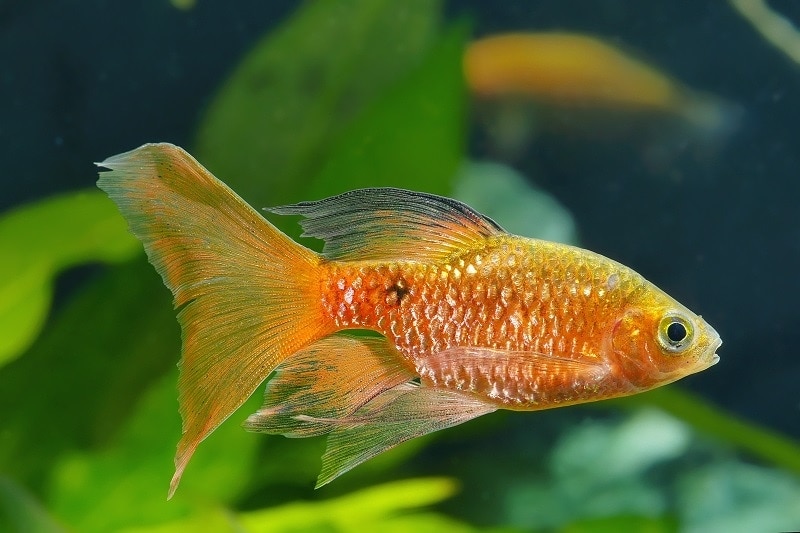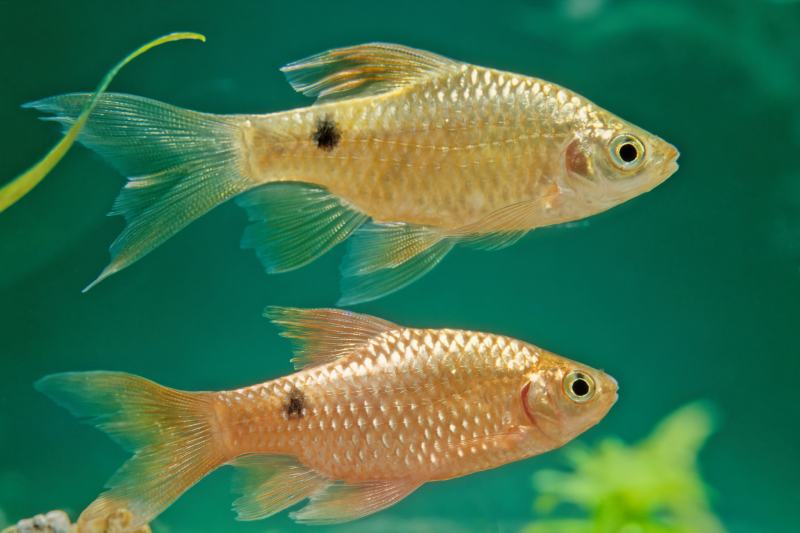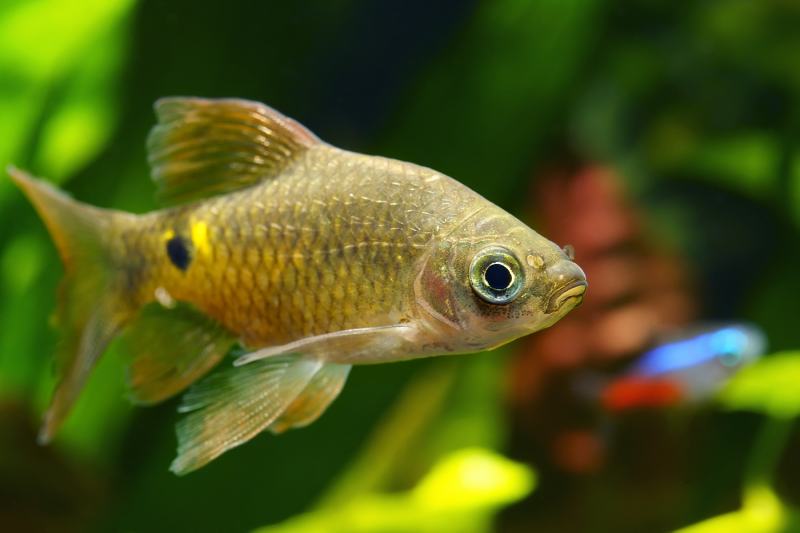- April 5, 2024
Rosy Barb: Care Guide, Pictures, Tank Setup, and Info


Rosy Barbs or Red Barbs are freshwater fish known for their vivid red coloration. They are some of the most popular Barbs kept in aquariums, mainly because they are easy to keep. The Rosy Barb’s peaceful and social temperament makes them well suited for community aquariums, and they get along well with many other fish.
Breed Overview
| Size: | Up to 6 inches long |
| Lifespan: | 5–6 years |
| Similar Breeds: | Cherry Barbs, Tiger Barbs, and Filament Barbs |
| Suitable for: | All fish keepers |
| Temperament: | Peaceful, non-aggressive, and social |
The Rosy Barb is a member of the Barbinae subfamily which is part of the Cyprinid family. You can easily recognize a Rosy Barb by their deep orange and reddish body with a distinctive black spot at the base of their caudal fin. Aside from being peaceful, Rosy Barbs are equally hardy and adaptable fish. Their ease of care makes them suitable for all fish keepers, even beginners who are looking for a first-time fish to own.
If you have set your mind on introducing Rosy Barbs to your aquarium, this article will guide you through their care requirements.
Rosy Barb Characteristics
Rosy Barb Cost?

Rosy Barbs originated from various southern Asian countries, such as Bangladesh, India, and Afghanistan. Populations of Rosy Barbs have been introduced outside their native range to waters throughout Australia, Singapore, Mexico, and Colombia. They inhabit various freshwater lakes, swamps, ponds, and streams which are either fast-flowing or slow-moving.
Their diverse habitat range is one of the main reasons behind their hardiness and adaptability in aquariums. They are well-known in the aquarium trade industry where they are sold under the common name Red or Rosy Barb and the scientific name Pethia conchonius.
Rosy Barbs are mainly kept in aquariums for ornamental purposes, but sometimes for breeding and rarely for human consumption. You can find Rosy Barbs for sale in many pet stores around the world. They usually cost between $3 to $8 per fish, but groups of Rosy Barbs are often sold at a discounted price.
Sociability of the Rosy Barb
Do These Fish Make Good Pets?
Rosy Barbs are good pet fish for both beginner and experienced fish keepers. They make active and lively additions to well-established community aquariums while being relatively easy to care for. Even beginner fish keepers who don’t have much experience caring for fish will find that Rosy Barbs aren’t difficult to own.
However, proper living conditions and good water quality are still important for Rosy Barbs. They need a spacious tank equipped with a filter, along with well-maintained water, regular water changes, and compatible tank mates. Despite being hardy and easy to care for, Rosy Barbs are not a good addition to bowls, vases, and other small aquaria.

Does This Fish Make a Good Tankmate?
One of the main reasons Rosy Barbs are chosen for community aquariums is because of their sociability. Rosy Barbs are compatible with various fish and invertebrates which can be introduced as tank mates.
Good Tank Mates:
- Dwarf Gourami
- Swordtails
- Guppies
- Mollies
- Neon Tetras
- Pearl Danios
- Harlequin Rasboras
- Bronze Corydoras
- Freshwater snails (Mystery, Nerite, or Ramshorn)
Rosy Barbs tend to fin-nip in aquariums. This makes them a poor tank mate for long-finned fish such as Bettas or Long-finned Tetras. You should never house Rosy Barbs with fish that are large, aggressive, or thrive at different water parameters. Jack Dempsey fish, African cichlids, and Oscars make bad tank mates for Rosy Barbs and should be avoided.
While Rosy Barbs are social enough to get along with various tank mates, they need to be kept in groups of five or more. Rosy Barbs are social shoaling fish that need to be kept in same-species groups.
Care Guide & Tank Set Up
Rosy Barbs require a minimum tank size of 30 gallons for a group of five or six. The more Rosy Barbs you keep together or the larger their tank mates are, the bigger their tank needs to be. A spacious tank is always preferred over a smaller one.
Water Quality, pH, & Temperature
Rosy Barbs rely on good water quality for their health and longevity. They should be kept in freshwater aquariums that have been cycled weeks before any Rosy Barbs are added in. Rosy Barbs do not handle poor water quality well, which may cause them to become stressed or ill. The levels of ammonia and nitrite need to be controlled via the nitrogen cycle and kept at 0 ppm (parts per million). Nitrate is the by-product of the nitrogen cycle and is safe up until 20 ppm.
The aquarium can either be heated or unheated if the temperature stays between 65° to 77° Fahrenheit (18° to 25° Celsius). However, the temperature should ideally be kept constant with only gradual fluctuations to avoid stressing Rosy Barbs. A heater is optional for Rosy Barbs but does help keep the water temperature stable and warm. The pH of the water should be between 6.0 to 8.0, and the water hardness around 90 to 357 ppm.
Substrate
Sandy or fine gravel substrates can be used in Rosy Barb aquariums. The substrate will function as a growth medium for any live plants in the aquarium while providing Rosy Barbs with a natural environment. Avoid substrates that alter the pH or hardness of the water, leach toxins, or have colorful dyes. The Rosy Barb’s vibrant coloration stands out against dark-colored substrates, rather than lighter ones.

Plants
Rosy Barbs benefit from live plants in their aquarium. Live plants such as java fern, Amazon sword, anubias, and Vallisneria are suitable for Rosy Barbs. These plants help purify the water, provide shelter, and replicate the vegetation Rosy Barbs experience in the wild. Furthermore, driftwood and rock formations can be added to the plants to liven up your Rosy Barbs aquarium. Dense vegetation encourages your Rosy Barbs to be more active because they may feel unsafe in a sparse one.
Lighting
Lighting is important for Rosy Barbs during the day as it creates a day-and-night cycle. Their aquarium should be moderately lit for 6 to 10 hours per day. The lights need to be turned off at night because Rosy Barbs rest in total darkness.
Filtration
Rosy Barbs require a filter in their aquarium to aid with water quality and prevent dirt buildup. In the wild, Rosy Barbs will inhabit fast streams or still waters. This means that filters can either produce a low current in the water or a moderately fast one. However, the filter should not be so strong that it makes it difficult for Rosy Barbs to swim comfortably. Most filters are suitable for Rosy Barb aquariums, including sponge, internal, external, and canister filters.

Things to Know When Owning a Rosy Barb:
Food & Diet Requirements
Rosy Barbs and omnivores in the wild and aquariums. They feed on various worms, insects, crustaceans, and plant matter in the wild. In captivity, Rosy Barbs enjoys eating a combination of live foods, commercial fish food, and spirulina or algae wafers. They are not fussy fish and generally eat any food that they are offered.
Their main source of nutrition should be from a commercial pellet, flake, granules, or sinking food formulated for tropical fish. Live foods like baby brine shrimp and daphnia can be offered a few times a week for variety. If you have other fish in the aquarium, Rosy Barbs will try to snack on their food too. Rosy Barbs should be fed once a day, and more frequently if they are still growing or if you plan to breed them. Any leftover food should be removed after 10 minutes to prevent the water from fouling.

Size & Growth Rate
Rosy Barbs generally grow larger in the wild than in captivity. The largest Rosy Barbs recorded and believed to be 6 inches long in the wild. However, they usually grow between 2.5 to 5 inches in captivity. Rosy Barbs have a moderately fast growth rate when kept in proper conditions and fed a healthy diet. A large tank, good water quality, and a balanced protein-rich diet will encourage your Rosy Barb to grow at a normal rate and reach a decent adult size. Rosy Barbs are considered sexually mature at around 2.5 inches long or 4 to 6 months old. It can take Rosy Barbs up to 12 months before they are fully grown.
Varieties
The Rosy Barb is a species of Barb fish, belonging to the minnow and carp family. They are characterized by their red or orange bodies, which are more vivid in males than females. Their coloration is enhanced during breeding season and males naturally have a brighter coloration than females. They have a single caudal, anal, and dorsal fin, along with pairs of ventral and pectoral fins. Rosy Barbs can either be found in the short-fin or long-finned variety. Males have black markings on their fins, and both sexes have a black dot just before their caudal fin.
Lifespan and Health Conditions
Rosy Barbs have a typical lifespan of around 5 years. However, some well-cared-for Rosy Barbs may live 1–2 years more. Their lifespans are relatively short and can be shorter if the Rosy Barbs have any healthy conditions or live in aquariums with poor water quality. Rosy Barbs will have similar health conditions as other tropical fish species. Although Rosy Barbs can tolerate cold water conditions, they may get certain diseases if they are kept in temperatures below 60 degrees Fahrenheit.
Serious Conditions
- Ich or white spot disease
- Ammonia toxicity
- Fin or tail rot
- Cottonmouth
- Internal parasites
- Bacterial or fungal infects
Male vs Female
Male Rosy Barbs are generally more colorful and slightly smaller than females. The female Rosy Barbs have a rounder abdomen and a larger body size. Female Rosy Barbs are more of a golden orange color, whereas males are redder. Aside from the difference in color and body structure, another way to tell male and female Rosy Barbs apart is by looking at their fins. Male Rosy Barbs have black markings on their fins whereas females do not.
3 Little-Known Facts About Rosy Barbs
1. Rosy Barbs are subtropical fish that can handle temperatures as low as 60 degrees Fahrenheit.
2. It is essential to keep Rosy Barbs in groups of five or more because they are naturally shoaling fish.
3. Rosy Barbs can adapt to various habitats, which makes them tolerant of different aquarium conditions.

Final Thoughts
Whether you are a beginner or an experienced fish keeper, Rosy Barbs might be a perfect choice for you. Rosy Barbs are peaceful and social shoaling fish that make perfect additions to well-established community aquariums. Their hardy and adaptable temperament makes them suited for both unheated and heated aquariums with good water quality.
It is fairly easy to keep Rosy Barbs happy and thriving, and all they need is a spacious and filtered tank with live plants. They do not have the longest lifespan at only 5 years long, but with proper care, some Rosy Barbs may live for longer.
Featured Image Credit: Grigorev Mikhail, Shutterstock
Tags
What do you think?
Related Articles

New Puppy Checklist: Gear You’ll Need for Your New Dog
Getting a new puppy is really exciting, but before you welcome them home, it’s important to prepare your space for them. Since puppies need a

How Big Do Mini Poodles Get? Vet Reviewed Average Weight & Growth Chart – Dogster
The information is current and up-to-date in accordance with the latest veterinarian research. Learn more » When you buy a Miniature Poodle, you might not

Can Police Dogs Smell Nicotine? Vet Verified Facts & Info – Dogster
The information is current and up-to-date in accordance with the latest veterinarian research. Learn more » While cigarette sales have been declining steadily for decades,

How Old Is 5 in Dog Years? Vet-Approved Guide to Each Size of Dog – Dogster
The information is current and up-to-date in accordance with the latest veterinarian research. Learn more » A common method for calculating a dog’s age is




